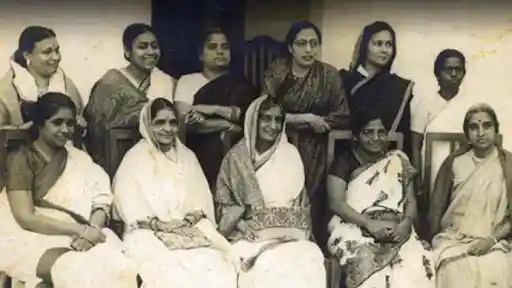A Ray of Resistance: Dakshyani Velayudhan, the Doubly Marginalised Indian
With a height of five feet and a slight slouch, Dakshyani Velayudhan understood the significance of standing erect with one’s head held high. The brightest ray of resistance, she is exclusively responsible for paving the path for millions of marginalised women. Defeating a system that has always encouraged discrimination, Velayudhan treaded barefoot on a path inlaid with blistering cinders.

(A revolutionary in the making; image source: The Print)
The mythical Sati, the daughter of Daksha, and the consort of Shiva, she is Dakshyani - a living, breathing woman beneath her symbolic namesake – Durga. Heroes, it is said, don’t announce their arrival. Could anyone have anticipated that a girl born in Kerala to Pulayar parents in 1912 would eventually change the pre-written fate of Dalit women and create a niche for herself in history? It was the 20th century, a period of “redefining modern existence”. Lives were changing, but only for the privileged.
Pulayar denoted a caste of agricultural labourers. They were untouchable and had to mandatorily stay twenty paces away from a Namboodiri, a Malayali Brahmin. Quite like North Indian rules of caste, Dalits were subjected to inhuman treatment, none of which Dakshyani escaped. Their lives spun around the dictates of the “upper caste”; by law, they could not cut their hair or cover their torso. A woman’s body has always been subjected to the male gaze, a marginalised woman’s more so. The position of a Dalit woman in society was precarious – she is a Dalit and a woman, making her doubly marginalised.
Interesting anecdotes about her life reveal that she received her first lessons in disobedience from her parents, who taught her to question every injustice inflicted upon her because of her caste. Growing up watching her extended family lead the fight against casteism through the Pulaya Mahajana Sabha and the famous meeting on the Backwaters of Kerala that inspired her autobiography’s title ‘The Sea has No Caste’, it was as though the stage was being set for Dakshyani. The world around her was changing; her kith and kin were learning to look eye-to-eye with their oppressors. It only made sense that she would sprout with the same fire burning her community with passionate intensity.
From the shadows of a community forcefully silenced, she rose like a phoenix. Dakshyani was the first Pulayar woman to wear a school uniform. By the mere act of covering herself, she had started exercising agency denied to Pulayar women for centuries. In effect, she was carrying out an ironic reversal of Draupadi’s vastra-haran. There was no divine intervention, she could not be left to God’s protection. A gifted student, she quickly finished her school education and proceeded to college for a degree in Chemistry. What gave her the perseverance and strength to endure the humiliation meted out to her is impossible to relay. From being barred to conduct experiments in the laboratory to finishing her graduation with flying colours, she fought a long and tough battle.
However, discrimination followed her everywhere. From classrooms to roads, as a student and as a teacher, her experience was a microcosm for a Dalit’s daily life, in a society so deeply entrenched in Brahminical values. By the time she had been nominated to the Cochin Legislative Council in 1945, Dakshyani’s upright, uncompromising and undeterred sympathy for the cause of the depressed classes was gaining prominence. By her own admission, she was a follower of both Gandhi and Ambedkar despite having certain reservations about some of their policies. As a woman of action, abstraction held no hope for her – calling Dalits “Harijans” served no practical remedy because it did not come with a guarantee of respect, security and equal opportunities. Similarly, the idea of separate electorates did not seem promising to her because real change could only come with moral safeguarding and not further division.
Her marriage to R. Velayudhan, a prominent Scheduled Caste leader and later M.P., made them the first Dalit couple in Parliament. Dakshyani’s life was dedicated to the cause of caste – she worked tirelessly for the marginalised so they could have easier access to resources – educational, professional, and the basic amenities of life.
As a pivotal moment in her extensive political career, the 34-years old Velayudhan’s participation in the Constituent Assembly that helped frame the Constitution of India earmarked a pedestal. She was one of the youngest and the only Dalit besides Ambedkar among 389 members of the Assembly who were involved in the drafting process. As the sole female representative of a community with a long-standing history of caste oppression and socio-political exclusion, she was shouldering the expectations of millions. B.R. Ambedkar is widely known as one of the greatest champions of lower caste rights, but Indians tend to forget Dakshyani Velayudhan’s contributions on “issues of untouchability, forced labour, reservations and separate electorates for Dalits”. In the sessions of Parliament, she was known for asking “too many questions” and exceeding stipulated time-limits. Even after withdrawing from active politics, she did not stop working for the vision she had for an equal India. In fact, she organised a forum called Mahila Jagriti Parishad to work among slum dwellers. She dedicated her entire life for the cause of equality. Dakshyani Velayudhan died on July 20, 1978. She walked a thorny path so her feet might bleed, but the light she lit for millions like her shall keep burning forever

(Velayudhan (top right); Women who helped frame the Constitution; source: India Today)


